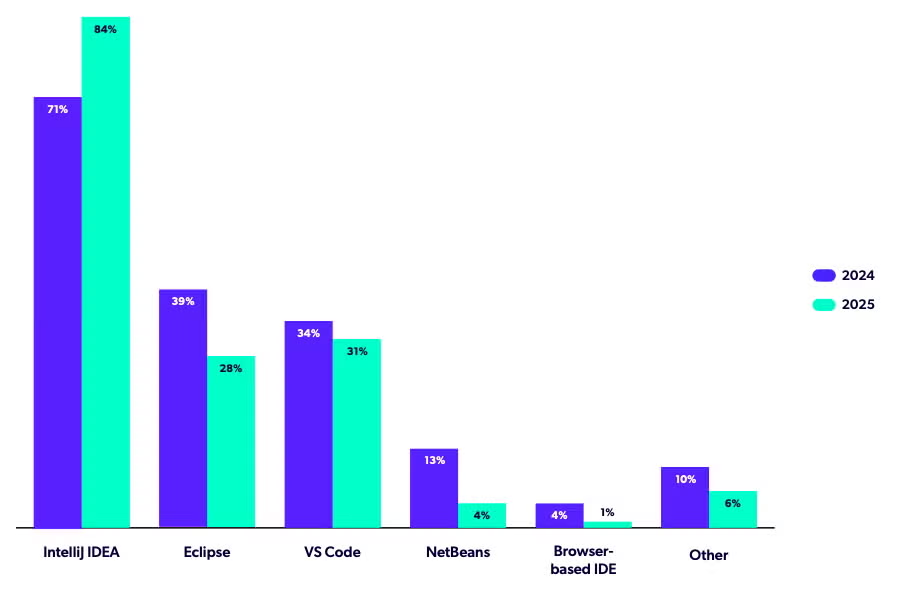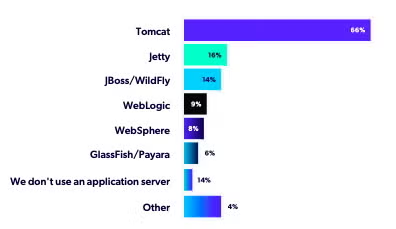Java is a vibrant ecosystem, full of wonderful tools and technologies designed to make working and creating with the language easier for developers. But the most popular Java development tools all have one thing in common — they make developing software and business applications in Java easier.
In this article, we look at the most popular aspects of a developer's Java tech stack, including IDEs and application servers.
Table of Contents
Top Development Tools in Java
It’s hard to determine what is and what isn’t a development tool these days. You could make a case that APM tools are development tools, or that testing frameworks are development tools. But, for the purposes of this article, we’re looking specifically at Java IDEs and Java application servers.
While some of these development tools aren't necessarily Java-specific, the data used to rank the top Java development tools and software in 2025 are from the 2025 Java Developer Productivity Report.
Back to topDig Into the Data
Download your copy of the 2025 Java Developer Productivity Report today.
Top Java IDEs
If you work in Java every day, you probably already know the top Java IDE. And, while we didn’t break our survey down into community or ultimate versions, we do know that IntelliJ IDEA has a loyal following among Java developers for its deep set of capabilities.

Source: 2025 Java Developer Productivity Report
The 2025 Java Developer Productivity Report found that 84% of Java developers are using IntelliJ IDEA. What's more notable is what comes after that top ranking. VS Code overtook Eclipse for the second-place ranking for the first time in 2025 at 31%, followed closely by Eclipse at 28%.
Respondents could select more than one IDE, and 42% did just that. Among respondents using IntelliJ IDEA as their primary IDE, 68% also reported using VS Code as a secondary IDE.
Read on for a closer look at why each IDE ranked at the top of the list.
1. IntelliJ IDEA
From live templates to code completion features, IntelliJ IDEA offers a polished and developer-empowering Java coding experience. Because it’s the de-facto standard for Java developers, it also has much more community support available (if you’re not using Ultimate, which provides additional dedicated support). Add to that a large selection of high-quality plugins (driven by rigid development standards for IntelliJ plugins), and you can see why IntelliJ IDEA is the reigning champ in Java IDEs.
So what stops IntelliJ IDEA from topping out at 100% of Java users? The biggest reason is price. IntelliJ IDEA is the only IDE on this list with a price tag attached and not all Java developers or development teams have the budget to splurge on a Ferrari-like IDE. For others, it’s performance overhead associated with IntelliJ IDEA.
🥇 Read this blog for an in-depth look at the best Java IDEs in 2025.
2. VS Code
Visual Studio Code, or VS Code, is the second most popular Java IDE of 2025 in our survey. It offers a lightweight, high-performance, and easy-to-use alternative to Eclipse. VS Code is also free, which makes it a popular secondary IDE. Some Java developers turn to VS Code alongside Java-specific IDEs (mainly IntelliJ IDEA) for specific features, including its debugging capabilities.
🐞 Learn more about debugging in VS Code.
While it doesn’t offer the functionality of IntelliJ IDEA, it does have a number of extensions that make it easy to work with various technologies.
⚙️ Get all the details on the JRebel extension for VS Code.
3. Eclipse
While not as popular or feature-rich as IntelliJ IDEA, Eclipse is still favored among a significant amount of developers. Why? Because it’s extensible, free, has a passable UX, and allows users to manage multiple workspaces simultaneously. Java developers find Eclipse much more customizable as well, allowing companies to create their own versions of the IDE for their own purposes like RAD or myEclipse.
Back to topDiscover how much Java development time your team can save with JRebel. Our ROI calculator takes your fixed costs and Java tech stack into account. Try it out today to see what savings you're leaving on the table.
Top Java Application Servers
A Java application server is a framework that hosts and runs a Java application. An application server enables a server to generate a dynamic, customized response to a client request.

Source: 2025 Java Developer Productivity Report
Respondents of the 2025 Java Developer Productivity Report were asked what application server they use. Tomcat was the clear winner at 86%, with Jetty (16%), JBoss/WildFly (14%), WebLogic (9%), and WebSphere (8%) trailing. Interestingly, 14% of respondents reported they don’t use an application server.
1. Apache Tomcat
Apache Tomcat is an open-source web server and Servlet container for Java code. It's a production-ready Java development tool used to implement many types of Jakarta EE (formerly known as Java EE) specifications.
While Java developers favored other application servers in the past, many have migrated to Apache Tomcat, owing to its popularity.
🐱 Read this primer on Apache Tomcat.
2. Jetty
Jetty has the ability to run an application like a traditional application server like Tomcat or Wildfly in what is called Standalone deployment. Jetty also has the functionality to operate as a servlet that is embedded in your existing application. This dual functionality makes Jetty the preferred application server of some Java developers.
3. JBoss/Wildfly
WildFly is a popular choice for Java developers who want to develop enterprise-capable applications, and do so without paying for a commercial application server. JBoss/WildFly provides a Java web application an extension to the JVM with a complete runtime environment that will create the connection of database on one end to the web client on the other. JBoss/WildFly is designed and maintained by Red Hat and was formally known as JBoss AS.
Back to topFinal Thoughts
Today, we’ve looked at a lot of tools that could be considered Java productivity tools. They all solve a problem, or help developers to complete their work faster. But in terms of high-ROI Java productivity tools, there are few tools that can have as high an impact on Java development as JRebel.
See how much time you could save during your 14-day free trial of JRebel.